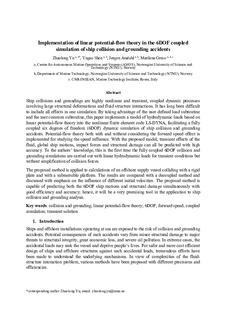Implementation of Linear Potential-Flow Theory in the 6DOF Coupled Simulation of Ship Collision and Grounding Accidents
Journal article
Submitted version
Permanent lenke
http://hdl.handle.net/11250/2468890Utgivelsesdato
2016Metadata
Vis full innførselSamlinger
- Institutt for marin teknikk [3397]
- Publikasjoner fra CRIStin - NTNU [37219]
Sammendrag
Ship collisions and groundings are highly nonlinear and transient, coupled dynamic processes involving large structural deformations and fluid structure interactions. It has long been difficult to include all effects in one simulation. By taking advantage of the user‐defined load subroutine and the user common variable, this article implements a model of hydrodynamic loads based on linear potential‐flow theory into the nonlinear finite element code LS‐DYNA, facilitating a fully coupled six degrees of freedom (6DOF) dynamic simulation of ship collision and grounding accidents. Potential‐flow theory both with and without considering the forward speed effect is implemented for studying the speed influence. With the proposed model, transient effects of the fluid, global ship motions, impact forces, and structural damage can all be predicted with high accuracy. To the authors' knowledge, this is the first time the fully coupled 6DOF collision and grounding simulations are carried out with linear hydrodynamic loads for transient conditions but without simplification of collision forces. The proposed method is applied to calculations of an offshore supply vessel colliding with a rigid plate and with a submersible platform. The results are compared with a decoupled method and discussed with emphasis on the influence of different initial velocities. The proposed method is capable of predicting both the 6DOF ship motions and structural damage simultaneously with good efficiency and accuracy; hence, it will be a very promising tool in the application to ship collision and grounding analysis.
